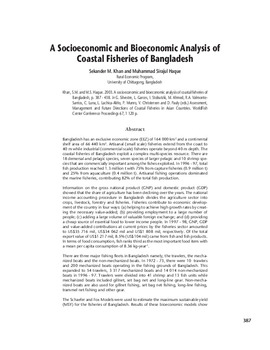A socioeconomic and bioeconomic analysis of coastal fisheries of Bangladesh

Citation
Khan, S.M.; Haque, M.S. (2003). A socioeconomic and bioeconomic analysis of coastal fisheries of Bangladesh. p. 387-438. Assessment, management and future directions for coastal fisheries in Asian countries. WorldFish Center conference proceedings; 67
Bangladesh has an exclusive economic zone (EEZ) of 164 000 km2 and a continental shelf area of 66 440 km2. Artisanal (small scale) fisheries extend from the coast to 40 m while industrial (commercial scale) fisheries operate beyond 40 m depth. The coastal fisheries of Bangladesh exploit a complex multi-species resource. There are 18 demersal and pelagic species, seven species of larger pelagic and 10 shrimp species that are commercially important among the fishes exploited. In 1996 - 97, total fish production reached 1.3 million t with 75% from capture fisheries (0.9 million t) and 25% from aquaculture (0.4 million t). Artisanal fishing operations dominated the marine fisheries, contributing 82% of the total fish production. Information on the gross national product (GNP) and domestic product (GDP) showed that the share of agriculture has been declining over the years. The national income accounting procedure in Bangladesh divides the agriculture sector into crops, livestock, forestry and fisheries. Fisheries contribute to economic development of the country in four ways: (a) helping to achieve high growth rates by creating the necessary value-added; (b) providing employment to a large number of people; (c) adding a large volume of valuable foreign exchange; and (d) providing a cheap source of essential food to lower income people. In 1997 - 98, GNP, GDP and value-added contributions at current prices by the fisheries sector amounted to US$35716 mil, US$34062 mil and US$1808 mil, respectively. Of the total export value of US$1217 mil, 8.5% (US$104 mil) came from fish and fish products. In terms of food consumption, fish ranks third as the most important food item with a mean per capita consumption of 8.36 kg·year-1. There are three major fishing fleets in Bangladesh namely, the trawlers, the mechanized boats and the non-mechanized boats. In 1972 - 73, there were 10 trawlers and 200 mechanized boats operating in the fishing grounds of Bangladesh. This expanded to 54 trawlers, 3317 mechanized boats and 14 014 non-mechanized boats in 1996 - 97. Trawlers were divided into 41 shrimp and 13 fish units while mechanized boats included gillnet, set bag net and long-line gear. Non-mechanized boats are also used for gillnet fishing, set bag net fishing, long-line fishing, trammel net fishing and other gear. The Schaefer and Fox Models were used to estimate the maximum sustainable yield (MSY) for the fisheries of Bangladesh. Results of these bioeconomic models show that MSY is estimated to be 4029 t at MSY effort of 9317 standard fishing days (SFD) using Schaefer’s Model. MSY reached 4136 t at MSY effort of 11822 SFD using Fox’s Model. The current catch of 2444 t at an effort of 7491 SFD indicates over-fishing. If this situation continues, the fishery resources will diminish with time. Precautionary measures should be adopted by the Government to minimize if not totally prevent over-exploitation of the fishery resource in the Bay of Bengal. The Government should enact laws and ensure their enforcement. The present number of large trawlers and boat owners should not be allowed to increase. The trawlers and large boat operators should avoid intrusion into near-shore areas and reduce discards/by-catch problems. Artisanal fishers should abandon destructive fishing gear like estuarine set bag net (ESBN), push nets and current jall that kill small fish. Community-based management should be adopted with initiatives coming from the Government, other international and regional agencies and the stakeholders.
Permalink
Date Available
Type
Publisher
Countries
Copyright
CC BY 4.0
Research Themes
Topics
Language